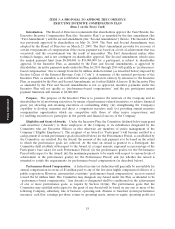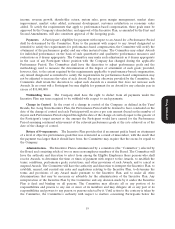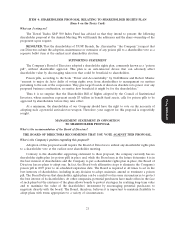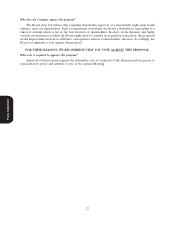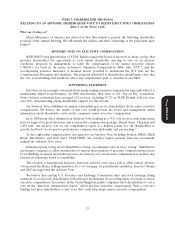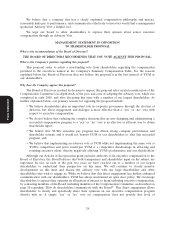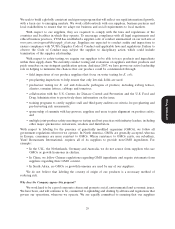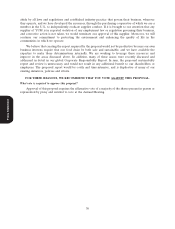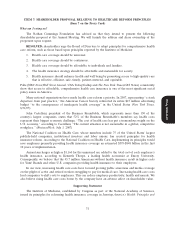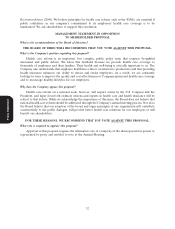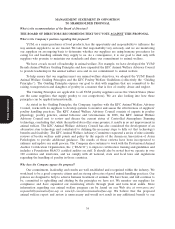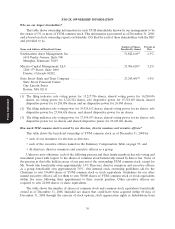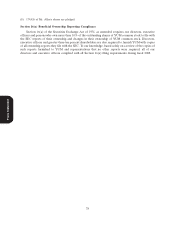Pizza Hut 2008 Annual Report Download - page 46
Download and view the complete annual report
Please find page 46 of the 2008 Pizza Hut annual report below. You can navigate through the pages in the report by either clicking on the pages listed below, or by using the keyword search tool below to find specific information within the annual report.
23MAR200920294881
The UN Food and Agriculture Organization (FAO) warned that increasing industrialization of pig and
poultry production ‘‘could lead to a higher risk of disease transmission from animals to humans.’’ The large
quantities of animal waste contain many pathogens and the movement of the animals in international trade
increases the likelihood pathogen transfers. The FAO cited the ‘‘recent emergence of contagious human
diseases from animals’’ such as Nipah in 1999, SAKS in 2002 and the current epidemic of Highly
Pathogenic Avian Influenza (HPAI). Industrial Livestock Production and Global Health Risks (June 2007).
http://www.fao.org/ag/againfo/projects/en/pplpi/docarc/rep-hpa i_industrialisationrisks.pdf
RESOLVED: Shareholders request that the Board of Directors report to shareholders by December,
2009 on measures taken to ensure the long-term sustainability and security of our company’s product
supply chain, including:
• Strategies to significantly reduce waste, energy and water use throughout the supply chain;
• Resource conservation programs and pollution prevention measures for the full product life-cycle;
• Labeling products for country of origin and presence of genetically modified ingredients; and
• Safety testing and systems to ensure identity preservation and traceability ‘‘from farm to fork.’’
MANAGEMENT STATEMENT IN OPPOSITION
TO SHAREHOLDER PROPOSAL
What is the recommendation of the Board of Directors?
THE BOARD OF DIRECTORS RECOMMENDS THAT YOU VOTE AGAINST THIS PROPOSAL.
What is the Company’s position regarding the sustainability proposal?
YUM is fully committed to ensuring that all of our facilities and supply chains, whether in the U.S. or
any other country, are operated legally, ethically and responsibly and in a manner that benefits the
communities in which they are located. Our Worldwide Code of Conduct, summarized on our Web site,
under the ‘‘Governance’’ section, guides our activities around the world. You can download a copy of our
Worldwide Code of Conduct at www.yum.com/governance/conduct.asp. It commits us to act as an
Proxy Statement
environmentally responsible corporate citizen, to provide a safe and healthy work environment, and to
seek methods that are both socially responsible and economically sound.
We are proud of our recent accomplishments in this area. For example, in 2006 we established a
dedicated Corporate Social Responsibility role with the goal of reviewing and assessing our global impacts
in social, environmental and economic areas and developing strategies and initiatives in response. We also
issued our first global Corporate Responsibility report in 2008 addressing areas of achievement and
opportunity relating to social, environmental and economic impacts. You can download a copy of our
Corporate Responsibility report at www.yum.com/responsibility/pdf/yum08csrrpt.pdf. In 2006, YUM also
formed an Environmental Leadership Council whose goal is to identify, design, test and deploy programs
that drive measurable sustainability advances. Some of the aspects of our business that this committee is
addressing include: building materials and design, energy conservation, energy procurement, waste,
packaging and education. With respect to energy conservation, our U.S. company-owned restaurants have
significantly reduced energy use since 2005, and are well on their way to achieving a stated goal of 12%
reduction in energy use from 2007 levels by 2010. Our entire system of restaurants is also in the process of
implementing equipment and behavior changes and retrofits that address environmental impact, including
energy and water use, recycling of cardboard and paper products, recycling of spent grease from fryers, use
of energy efficient equipment and better energy management systems.
We recognize that our decentralized business model, with predominantly franchised restaurants in
over 110 countries and territories as well as manufacturing and processing plants in even more countries,
will require a customized approach to addressing supply chain opportunities in our international markets.
28


